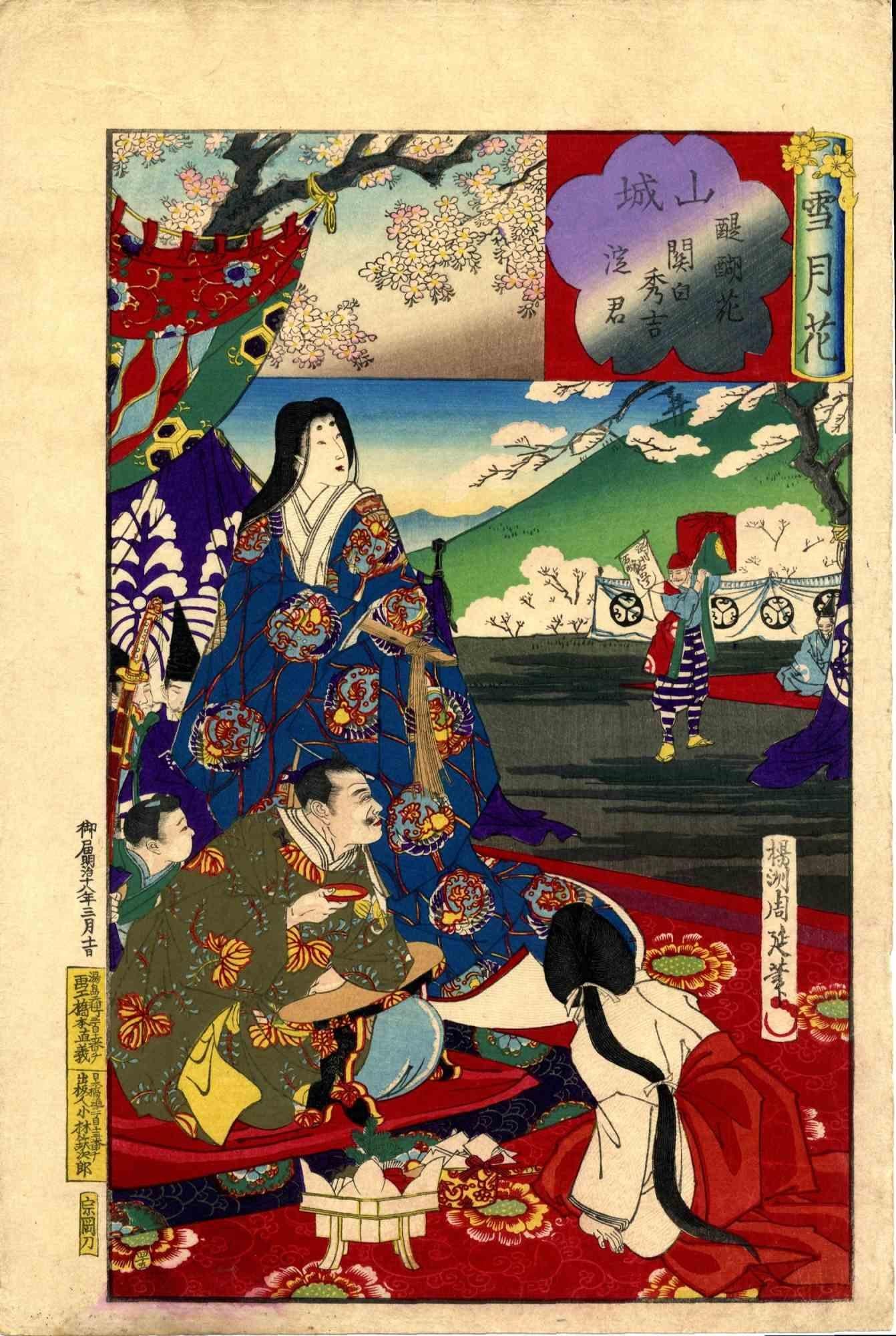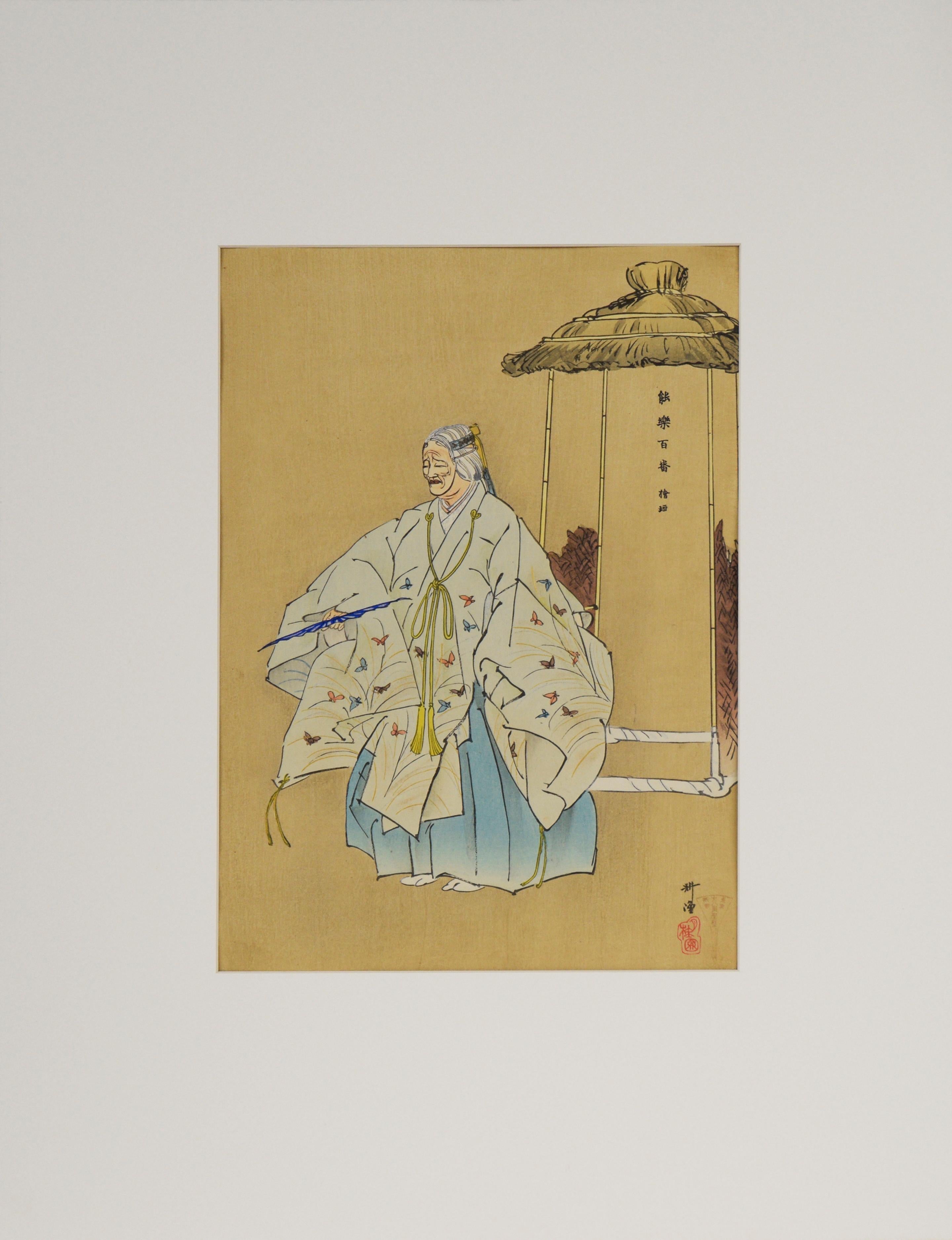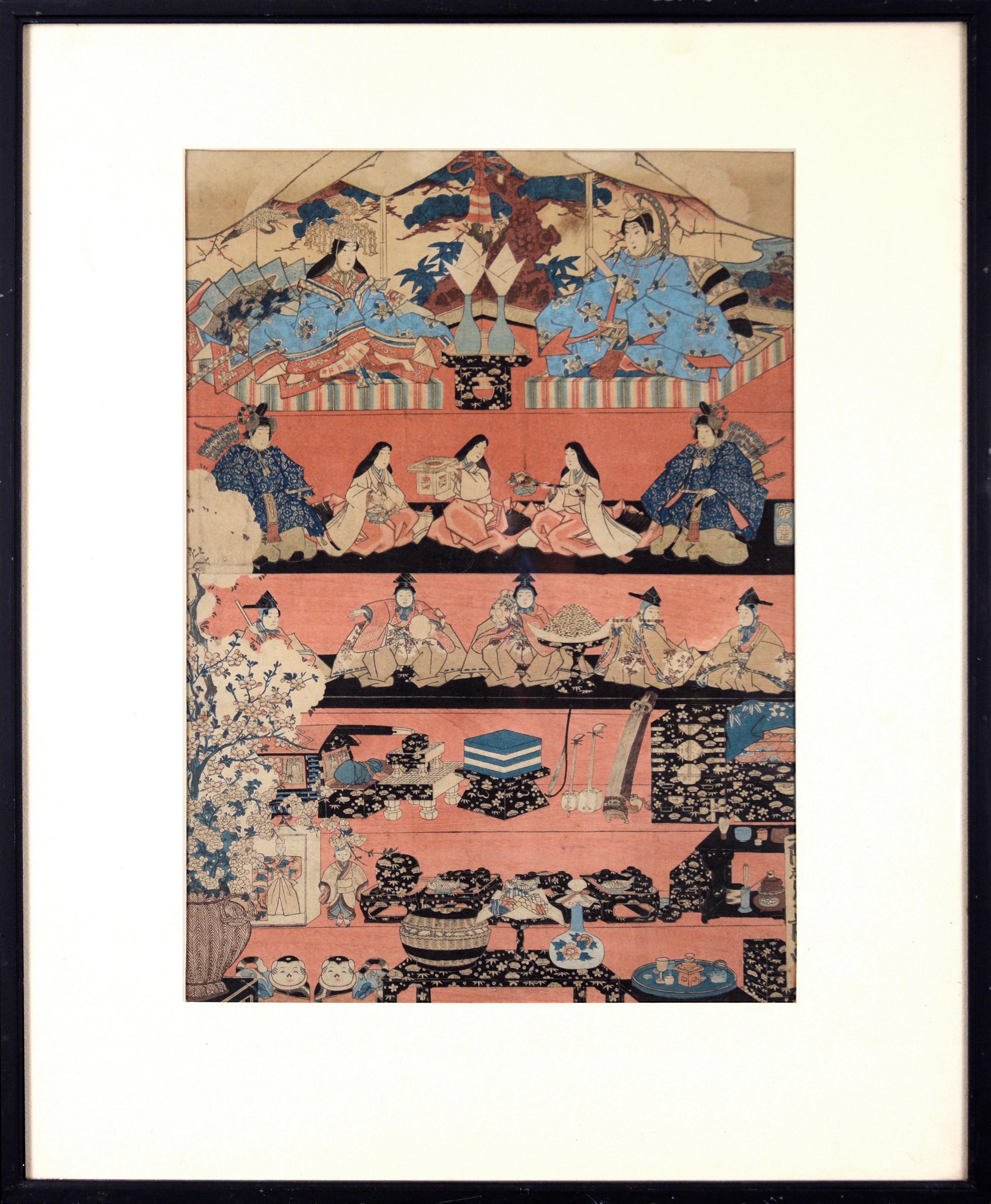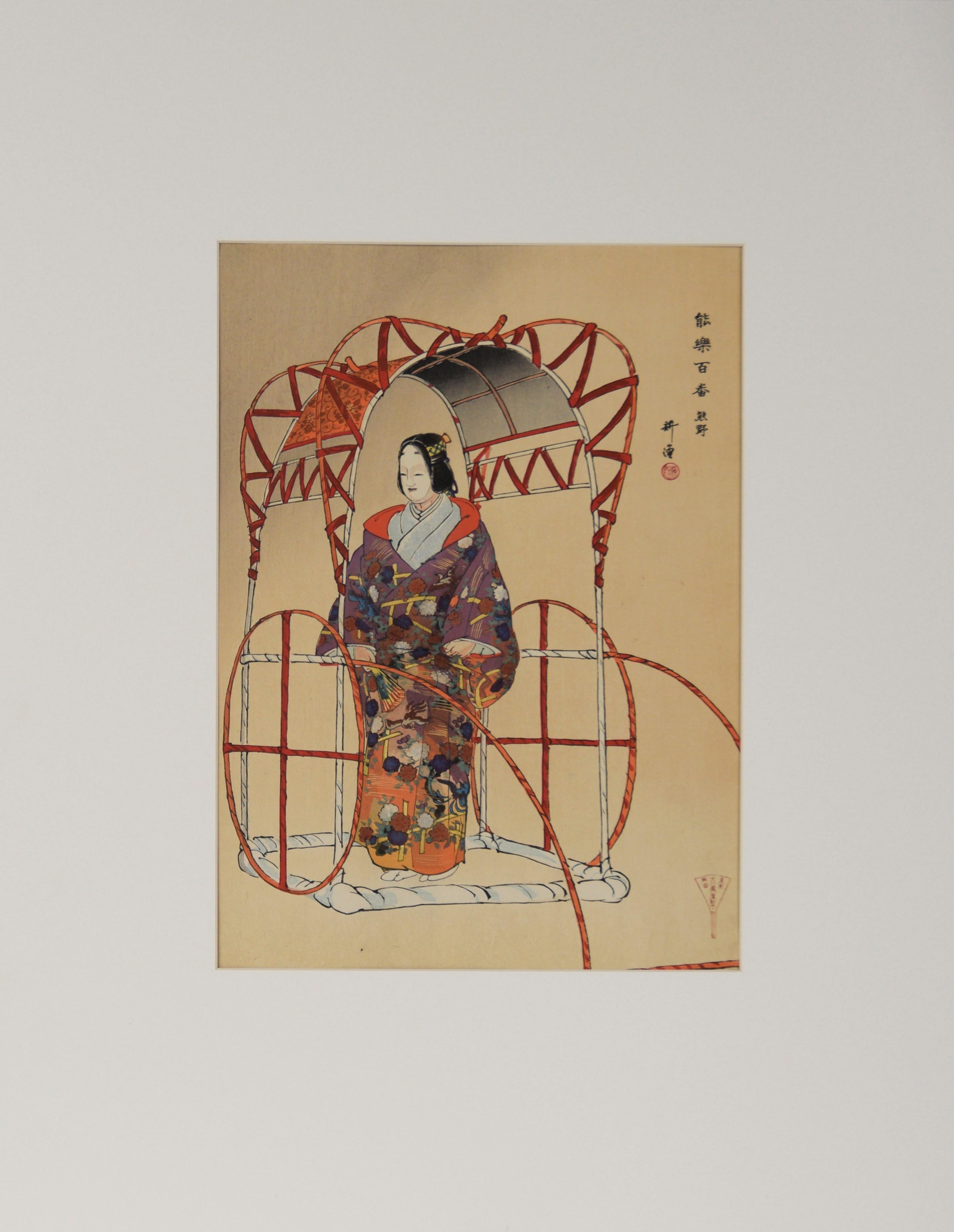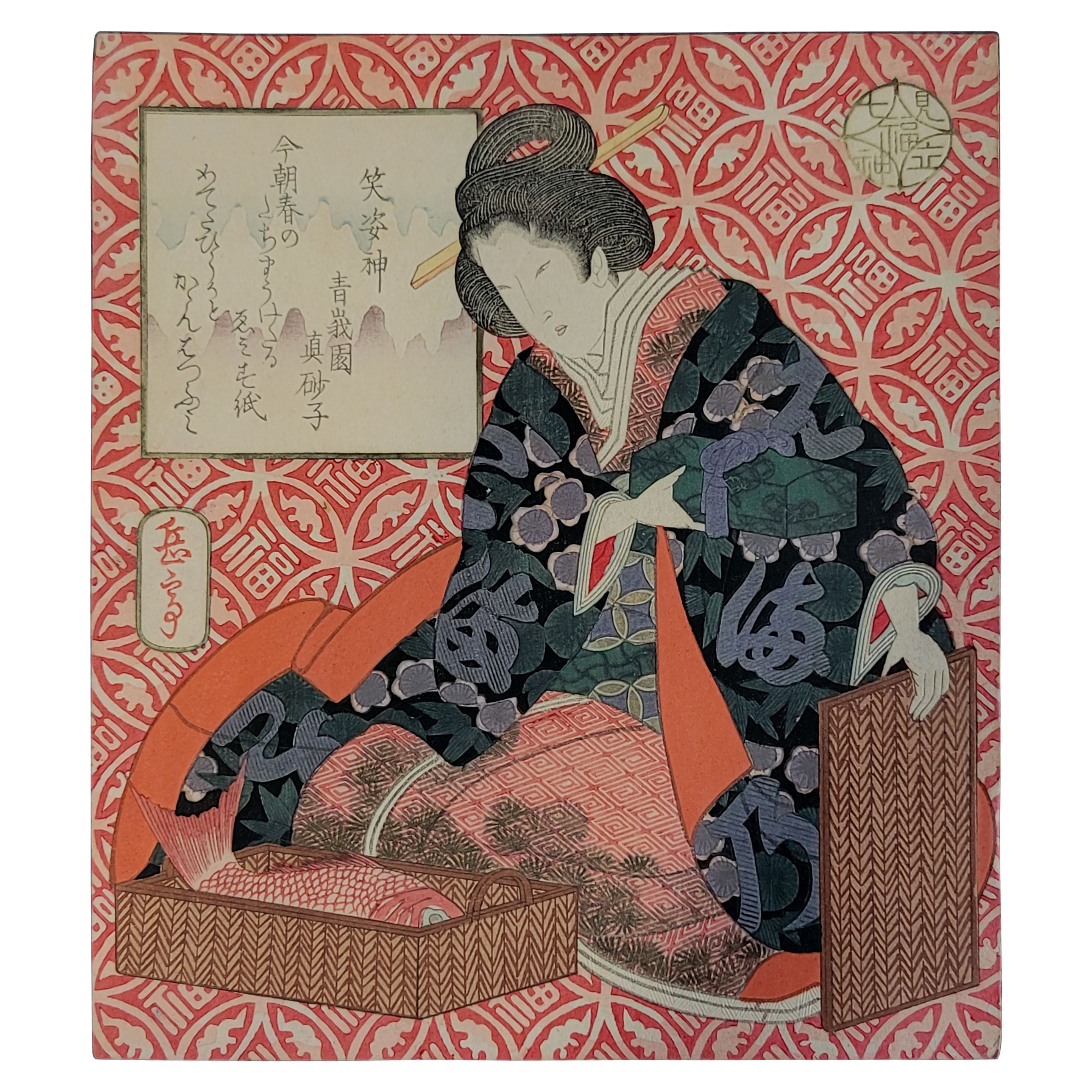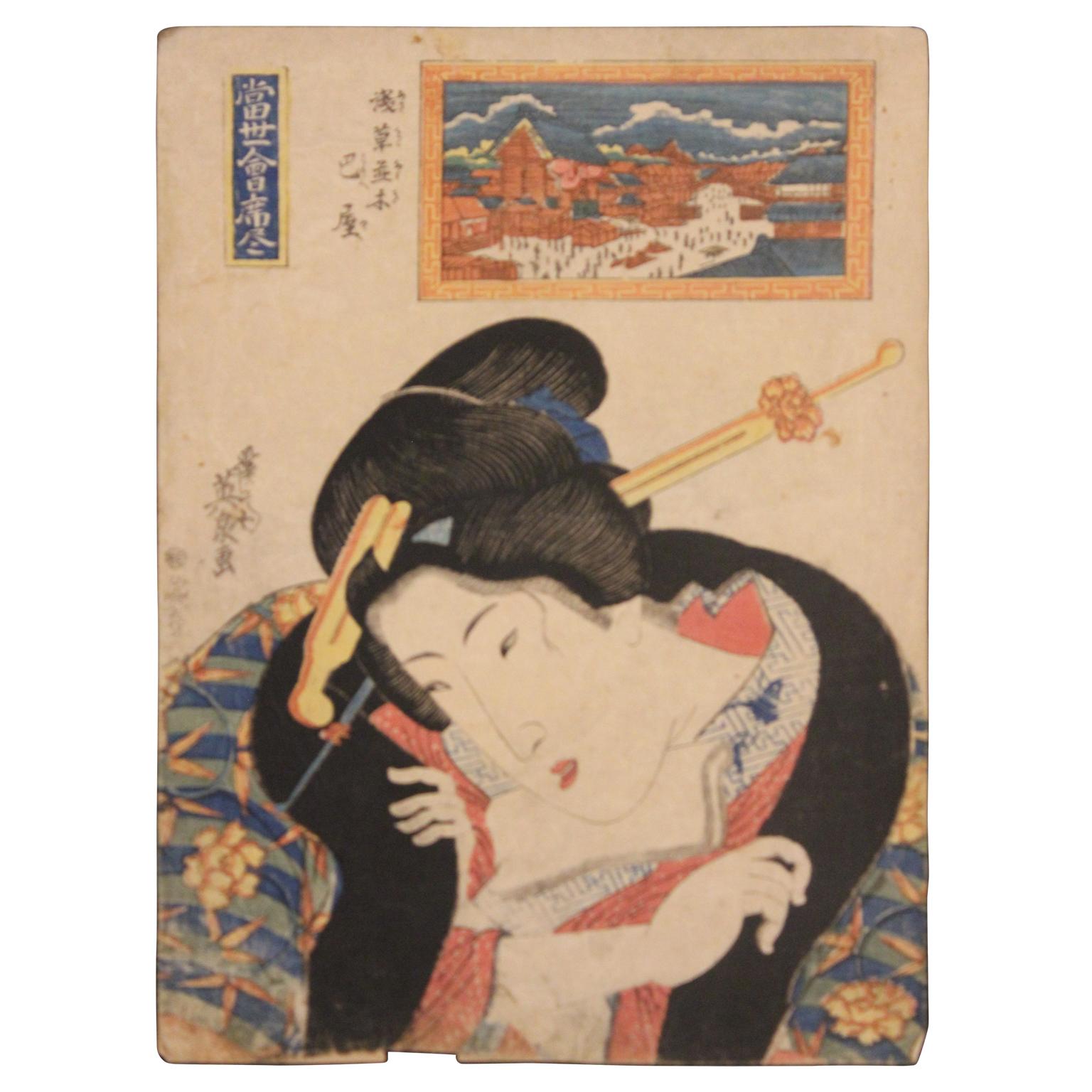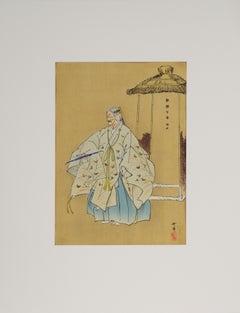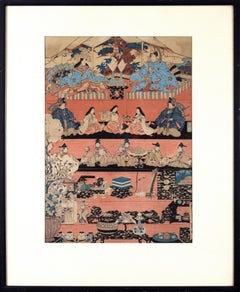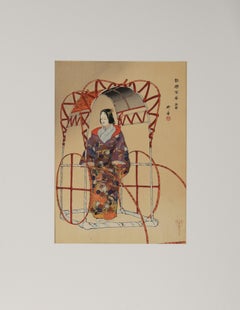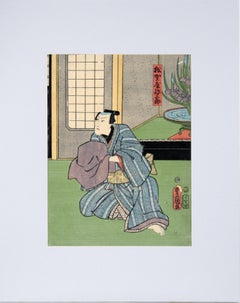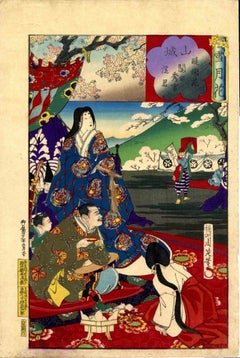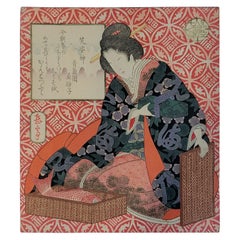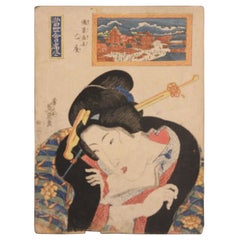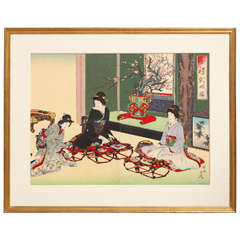Items Similar to "Enshoku Sanju-roku Kasen" (Thirty-six Enchanting Flowers) Woodblock on paper
Want more images or videos?
Request additional images or videos from the seller
1 of 17
Toyohara Kunichika"Enshoku Sanju-roku Kasen" (Thirty-six Enchanting Flowers) Woodblock on paper1881
1881
$380
$47520% Off
£286.78
£358.4720% Off
€328.31
€410.3920% Off
CA$535.93
CA$669.9120% Off
A$588.38
A$735.4720% Off
CHF 306.96
CHF 383.7020% Off
MX$7,120.22
MX$8,900.2720% Off
NOK 3,847.26
NOK 4,809.0720% Off
SEK 3,625.13
SEK 4,531.4120% Off
DKK 2,450.78
DKK 3,063.4820% Off
About the Item
"Enshoku Sanju-roku Kasen" (Thirty-six Enchanting Flowers) Woodblock on paper
Elegant woodblock print by Toyohara Kunuchika (Japanese, 1835-1900). Three women are in talking with each other inside, while a man waits outside holding a bag of some kind. The colors in this piece are rich and saturated, primarily blues, greens, and purple.
Mat size: 16"H x 20"W
Paper size: 14.75"H x 9.88"W
Born in 1835, Toyohara Kunichika grew up in the Kyobashi district of Edo in the midst of merchants and artisans. In 1848, at age 13, he was accepted as an apprentice into the studio of Utagawa Kunisada I (Toyokuni III 1786–1865).
Kunichika's work stands in contrast to that of many of his contemporaries as he persistently held onto the traditional style and subject matter of the classic Japanese woodcut, unaffected by new Western forms of art. His love of Kabuki inspired him to depict actors in their various roles and varying facial expressions. His skillful use of color and ability to translate the actor's depth of emotion onto the page makes his work some of the most dramatic ever produced. Later on in his career, Kunichika turned primarily to the triptych format as the increased size gave him the space to fully portray the drama and action of the characters represented.
- Creator:
- Creation Year:1881
- Dimensions:Height: 20 in (50.8 cm)Width: 16 in (40.64 cm)Depth: 0.25 in (6.35 mm)
- Medium:
- Movement & Style:
- Period:
- Condition:Very good with some fraying at the sides.
- Gallery Location:Soquel, CA
- Reference Number:Seller: DBH84121stDibs: LU54212217102
About the Seller
5.0
Platinum Seller
Premium sellers with a 4.7+ rating and 24-hour response times
Established in 1986
1stDibs seller since 2014
3,000 sales on 1stDibs
Typical response time: <1 hour
- ShippingRetrieving quote...Shipping from: Soquel, CA
- Return Policy
Authenticity Guarantee
In the unlikely event there’s an issue with an item’s authenticity, contact us within 1 year for a full refund. DetailsMoney-Back Guarantee
If your item is not as described, is damaged in transit, or does not arrive, contact us within 7 days for a full refund. Details24-Hour Cancellation
You have a 24-hour grace period in which to reconsider your purchase, with no questions asked.Vetted Professional Sellers
Our world-class sellers must adhere to strict standards for service and quality, maintaining the integrity of our listings.Price-Match Guarantee
If you find that a seller listed the same item for a lower price elsewhere, we’ll match it.Trusted Global Delivery
Our best-in-class carrier network provides specialized shipping options worldwide, including custom delivery.More From This Seller
View AllOne Hundred Prints Of The Noh - 1925 Original Japanese Woodblock Print
Located in Soquel, CA
One Hundred Prints Of The Noh - 1925 Original Japanese Woodblock Print
Original Japanese woodblock print by Tsukioka Kogyo (Japanese, 1869...
Category
1920s Edo Figurative Prints
Materials
Ink, Rice Paper, Woodcut
"Various Himochi" Wagashi Festival Japanese Woodblock Print by Utagawa Toyokuni
By Utagawa Toyokuni
Located in Soquel, CA
"Various Himochi" Wagashi Festival Japanese Woodblock Print by Utagawa Toyokuni
Rare oversized early 19th century 5-tiered woodblock by Utagawa Ichiyosai Toyokuni, (Japan, 1769-1825), a Japanese lord and wife oversee a sekku festival of food, music, and dolls or toys. '"oshi" is the first day of “Mi (Snake)” in the third month of the lunar calendar. This day, known in modern Japan as the Girls' Festival, originated in China as a form of purification ceremony in which water and drinking peach blossom wine were used to drive away evil. Many kinds of hishi-mochi appear in this picture of hina ningyo (dolls associated with Hinamatsuri, or the Girl’s Day) from Omochae.
The custom of eating special dishes at events throughout the year and at milestones in people's lives has existed since ancient times. This paragraph specifically focuses on the annual event called sekku, and life events that involve eating sweets. Joshi is the first day of “Mi (Snake)” in the third month of the lunar calendar. This day, known in modern Japan as the Girls' Festival, originated in China as a form of purification ceremony in which water and drinking peach blossom wine were used to drive away evil. According to the Keiso saijiki, in ancient China, on the third day of the third lunar month, people ate “ryuzetsuhan,” which is the juice of gogyo (Jersey cudweed) mixed with rice flour and nectar. In Japan, there is a record in the Heian period history book Nihon Montoku tenno jitsuroku [839-5] that it was an annual event to make kusamochi using gogyo on the third day of the third month of the lunar calendar, which may have been influenced by Chinese customs.
The tradition of eating kusamochi on the third day of the third month of the lunar calendar continued after that. By the Edo period, however, hishimochi had come to be used as a sweet to serve on the third day of the third month. A picture of a hishimochi is included in the Morisada manko , which we mentioned in Part 1. According to it, hishimochi in the Edo period were often three layers of green-white-green instead of the now common red-white-green. However, it is possible to see from our collection that not all hishimochi were made in this way. Omochae published in 1857, is a good example. Omochae is a type of ukiyoe print...
Category
1820s Edo Figurative Prints
Materials
Ink, Rice Paper, Woodcut
"Pictures Of Noh" - 1922 Original Japanese Woodblock Print
Located in Soquel, CA
"Pictures Of Noh" - 1922 Original Japanese Woodblock Print
Original Japanese woodblock print by Tsukioka Kogyo (Japanese, 1869-1927...
Category
1920s Edo Figurative Prints
Materials
Ink, Rice Paper, Woodcut
"Sun Saburo Matsugaya" - Mid 19th Century Figurative Japanese Woodblock Print
By Utagawa Kunisada (Toyokuni III)
Located in Soquel, CA
"Sun Saburo Matsugaya" - Mid 19th Century Figurative Japanese Woodblock Print
Beautiful mid 19th century figural Japanese woodblock print of a seated man with lilies in the background by Utagawa Toyokuni III (Kunisada) (Japanese, 1786-1864/5). Artist's chop is in the lower right corner of the piece. The actor is Magosaburo Matsugaya from the play "Katakiuchi Rumors"
Presented in a new grey-blue mat with foamcore backing.
Mat size: 21"H x 16"W
Paper size: 14"H x 9.75"W
During his lifetime Kunisada Utagawa...
Category
1850s Edo Figurative Prints
Materials
Paper, Ink, Woodcut
"Juro Sukenari, Station #9: Oiso", Mid 19th Century Japanese Ukiyo-e Woodblock
By Utagawa Kunisada (Toyokuni III)
Located in Soquel, CA
Beautiful mid 19th century Japanese woodblock print of a samurai by Utagawa Toyokuni III (Kunisada) (Japanese, 1786-1864/5). This piece is from a series of "The 53 Stations of the To...
Category
1860s Edo Figurative Prints
Materials
Paper, Ink
"Thirsty: the appearance of a town geisha in the Ansei era" - Woodblock on Paper
By Tsukioka Yoshitoshi
Located in Soquel, CA
"Thirsty: the appearance of a town geisha in the Ansei era" - Woodblock on Paper
From the series "Thirty-two Aspects of Customs and Manners" (Fuzoku sanjuniso)
Lively woodblock of a...
Category
1880s Edo Figurative Prints
Materials
Paper, Ink, Woodcut
You May Also Like
The Flowering Daigo - Woodcut by Toyohara Chikanobu - 1885
By Toyohara Chikanobu
Located in Roma, IT
The Flowering Daigo is an original artwork realized in 1885 by Toyohara Chikanobu (1838–1912).
Limited edition woodcut print signed on plate.
From the series "Setsu gekka", (Snow, ...
Category
1880s Modern Figurative Prints
Materials
Woodcut
Japanese Woodblock Gakutei by Yashima Gakutei (1786-1868)
Located in Norton, MA
Japanese Woodblock Gakutei (1786-1868) by Harunobu Sugawara, original and unframed.
ABOUT THE ARTIST
Yashima Gakutei (1786-1868)
Born in Edo as Harunobu Sugawara, Gakutei Yashima studied printmaking under Shuei and Hokkei. He moved to Osaka in the 1830s, where he designed landscape studies of his new home with a delicate and decorative style likely influenced by Hokusai. In addition to printmaking, he wrote kyoka (comic poems), often illustrating these verses in his prints. While a talented woodblock artist, Gakutei was also known throughout Japan as a writer. He translated and illustrated the 16th century Chinese novel Journey to the West.
Gakutei Yashima’s oeuvre consists primarily of surimono. These deluxe, limited-edition prints blend the rich visual imagery of ukiyo-e with the ethereal art...
Category
Antique Early 19th Century Japanese Prints
Materials
Paper
Biensennyo-ko Japanese Woodblock Print
By Keisai Eisen
Located in Houston, TX
Japanese Woodblock print of a Biensennyo-ko a powder face women. Behind the women is a framed cityscape. The print is possibly from the series "Eight Favorite Things in the Modern World". The woodblock print is printed on rice paper. The print is not framed.
Artist Biography: Keisai Eisen...
Category
Early 1800s Edo Portrait Prints
Materials
Woodcut
Japanese Color Woodblock Print by Toyohara Chikanobu
By Toyohara Chikanobu
Located in New York, NY
This Meiji-period color woodblock by Toyohara Chikanobu (1838-1912) depicts three elegant female courtiers in traditional dress taking refreshments. Th...
Category
Antique Late 19th Century Japanese Meiji Prints
Materials
Paper
Sanjûroku Kasen... - Woodcut by Mizuno Toshikata - 1893
By Mizuno Toshikata
Located in Roma, IT
Nishiki-e (woodcut print), in vertical oban format (31x20.5) realized by Mizuno Toshikata in 1893 (Meiji 26).
Belongs to the Series "Sanjûroku Kasen" (Thirty-Six Beauties in Compari...
Category
1890s Modern Figurative Prints
Materials
Woodcut
Japanese Woodblock Print by Utagawa Yoshiika 落合芳幾 '1833-1904'
Located in Norton, MA
Japanese woodblock print by Utagawa Yoshiika 落合芳幾 (1833-1904), unframed.
About the artist
Yoshiiku was a popular ukiyo-e printmaker during the Meiji period. It is thought that he was the son of a tea house proprietor, hence his particular skill success in the portrayal of various beauties from teahouses and restaurants. Yet, he was an artist comfortable across subject matter and is recognized for his fierce portrayal of famous historical warriors. Yoshiiku was a student of Kuniyoshi and a contemporary rival of the famed Yoshitoshi. He signed his name Utagawa Yoshiiku...
Category
Antique Mid-19th Century Japanese Prints
Materials
Paper
More Ways To Browse
Antique Paper Flowers
Kunichika Woodblock Print
Ting Shao Kuang
Vintage Baby Angels
Vintage Posters Mucha
Wanda Gag
War And Peace Lithograph
William Sharp
American Football Art
Anders Shafer
Andy Mouse
Astro Boy
Basquiat Signed
Bill Schenck
Bob Dylan Poster Milton Glaser
Chagall Tamar
Circus Etching
Dali Hand Signed Etching
